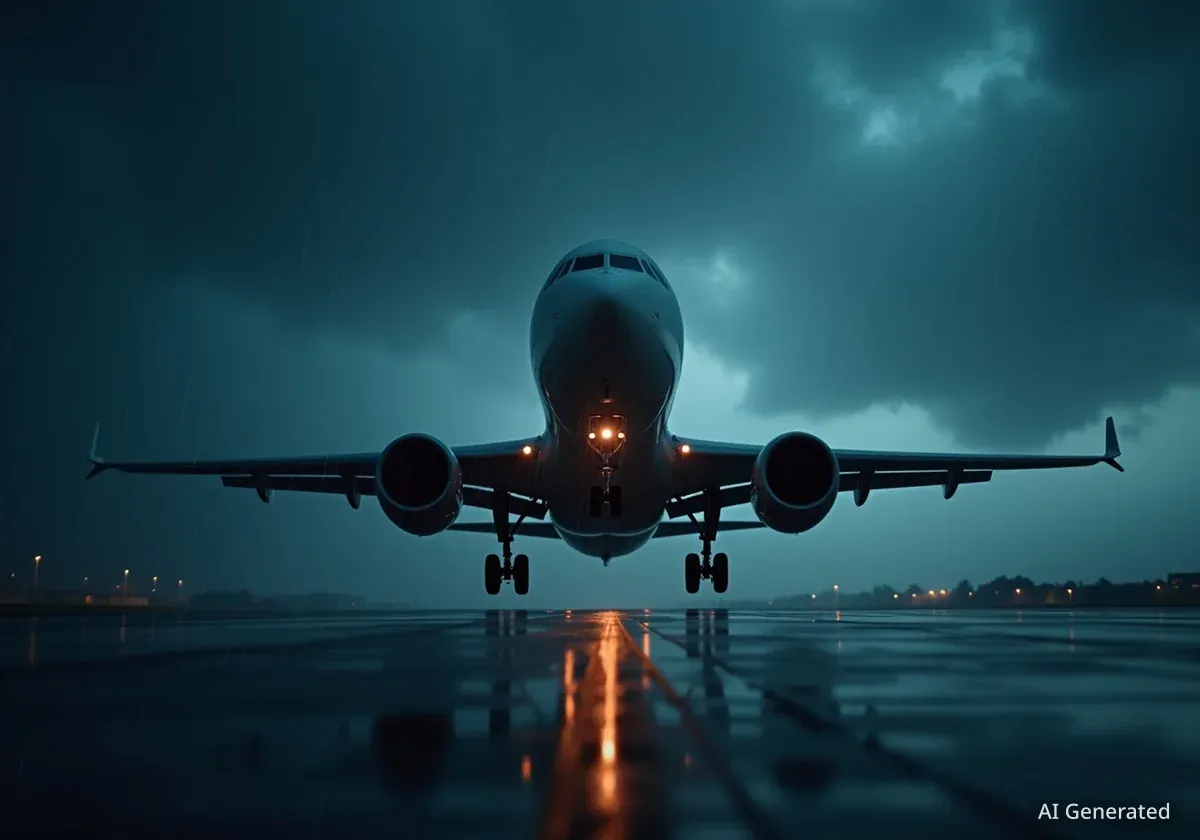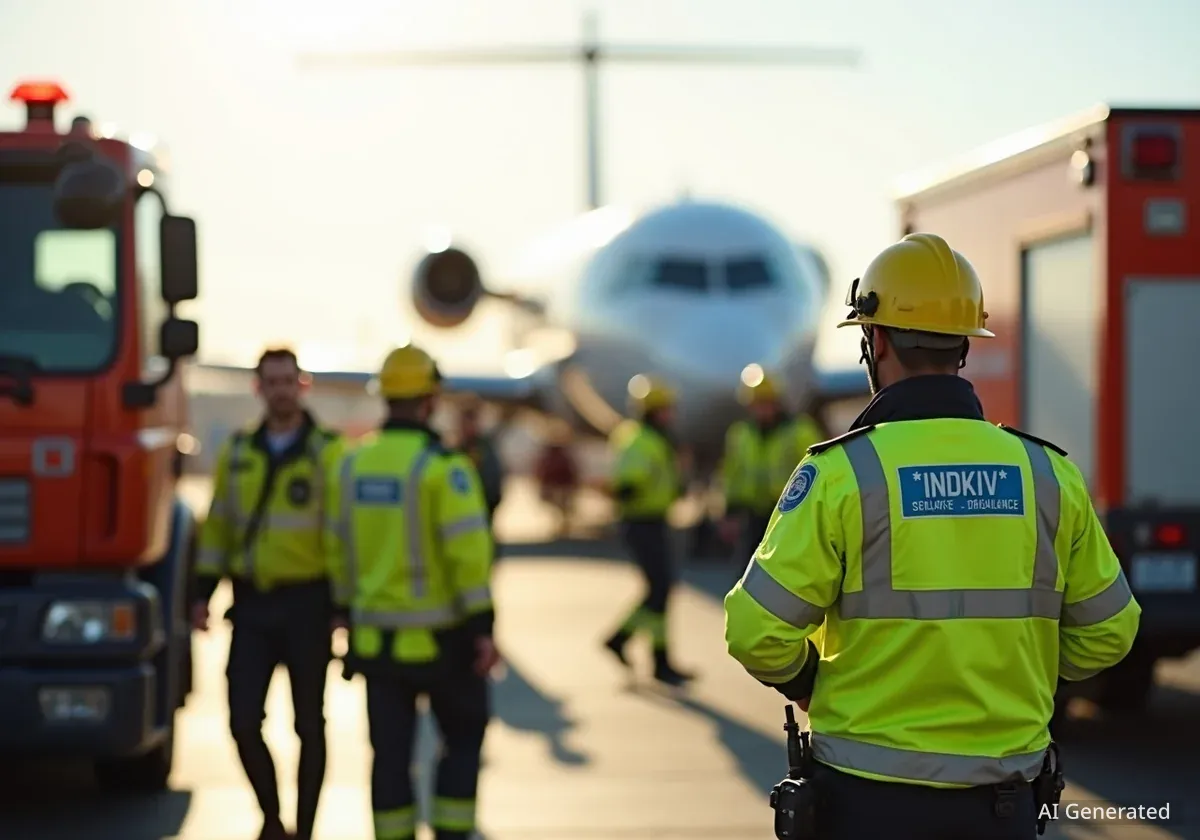A Ryanair flight from Pisa to Glasgow landed at Manchester Airport with only six minutes of fuel remaining. The incident occurred after the aircraft, a Boeing 737-800, made multiple unsuccessful landing attempts in Scotland due to severe weather conditions during Storm Amy. The UK's Air Accidents Investigation Branch (AAIB) has launched an investigation into this serious event.
Key Takeaways
- Ryanair Flight FR3418 landed with 220kg of fuel remaining, enough for only 5-6 minutes of flight.
- The flight diverted to Manchester after failing to land at Glasgow Prestwick and Edinburgh due to 100 mph winds.
- Pilots issued an emergency call before landing safely in Manchester.
- The UK's Air Accidents Investigation Branch (AAIB) is investigating the incident as a serious event.
- Regulations require aircraft to land with a 30-minute fuel reserve; this flight landed well below that.
Flight Encounters Severe Storm Conditions
Ryanair Flight FR3418, operated by Malta Air, departed Pisa, Italy, on Friday, October 3. The flight was bound for Glasgow Prestwick International Airport. Its departure was delayed by over an hour. As the aircraft approached Scotland, severe weather warnings were in effect. Wind speeds reached up to 100 miles per hour across the region.
Upon nearing Prestwick Airport, the Boeing 737-800, which can carry up to 189 passengers, encountered these strong winds. Flight tracking data from FlightRadar24 showed the plane circling Prestwick. It attempted to land twice but was unable to do so safely due to the conditions.
Flight Details
- Airline: Ryanair (operated by Malta Air)
- Flight Number: FR3418
- Date: October 3, 2025
- Departure: Pisa (PSA)
- Scheduled Arrival: Prestwick (PIK)
- Diversion: Manchester (MAN)
Multiple Diversions and Emergency Declaration
After the failed attempts at Prestwick, the pilots made the decision to divert to Edinburgh Airport. However, conditions in Edinburgh were also difficult. The aircraft attempted another landing there but had to abort and pull up sharply. This further reduced the aircraft's fuel reserves.
With options dwindling and fuel levels becoming critical, the flight crew then chose to divert to Manchester Airport. Manchester offered milder weather conditions compared to Scotland. The flight had been scheduled to land in Glasgow at 7:00 PM local time but remained airborne for nearly two additional hours.
One pilot, speaking to The Guardian, described the incident as "as close to a fatal accident as possible," highlighting the severity of the situation.
As the aircraft approached Manchester, the pilots issued an emergency call. This declaration signals that the aircraft's fuel reserves were critically low. The plane landed safely at Manchester at 8:51 PM local time.
Critically Low Fuel Levels on Landing
Upon landing in Manchester, the aircraft had a minimal amount of fuel remaining. According to The Aviation Herald, the Boeing 737-800 had only 220 kilograms of fuel left in its tanks. This amount translates to approximately five to six minutes of flying time. For context, this is barely enough time for a single go-around maneuver if the landing attempt in Manchester had also failed.
Aviation Fuel Regulations
Under international aviation regulations, aircraft are required to carry enough fuel to reach their destination, alternate airports, and then fly for an additional 30 minutes at 1,500 feet. This 30-minute supply is known as the final reserve fuel. Pilots are instructed never to reach the point of using this final reserve fuel. An aircraft that falls below this level while still airborne must declare a fuel emergency.
The aircraft involved in the incident is a Malta Air Boeing 737-800, registered as 9H-QBD. This aircraft is ten years old and is configured with 189 economy class seats. The fact that it landed well below the required final reserve fuel level is a key aspect of the ongoing investigation.
Passenger Experience and Aftermath
Passengers on board Flight FR3418 endured a difficult journey. They experienced three aborted landing attempts amidst strong winds. The flight, which typically takes 2 hours and 25 minutes, lasted 4 hours and 15 minutes before landing in Manchester.
Many passengers did not realize the severity of the fuel situation until after they had landed. One passenger shared their experience with the Ayr Advertiser, describing being "buffeted around a lot and jumping" during the heavy winds. They later understood the seriousness of the event after seeing images of the remaining fuel online.
- Typical Flight Time: 2 hours 25 minutes
- Actual Flight Time: 4 hours 15 minutes
- Passengers: Up to 189
After landing in Manchester, passengers were transported by bus to Prestwick Airport, their original destination. This bus journey meant they arrived at Prestwick ten hours later than their scheduled arrival time. Other flights that evening also faced similar challenges. Another Ryanair flight from Malaga, for example, also failed to land at Prestwick and diverted to other airports like Manchester and London Stansted.
Investigation Underway by AAIB
The UK's Air Accidents Investigation Branch (AAIB) has confirmed it is investigating this incident. The AAIB classifies this event as a "serious incident." The primary focus of the investigation will be to understand why the aircraft landed with such a low fuel reserve and the decision-making process that led to the multiple diversions.
A spokesperson for Ryanair stated, "Ryanair reported this to the relevant authorities. As this is now subject of an ongoing investigation, which we are cooperating fully with, we are unable to comment." The airline is fully cooperating with the AAIB's inquiry.
The investigation will likely examine several factors. These include the initial fuel planning, the meteorological conditions, air traffic control decisions, and the crew's actions during the series of diversions. Understanding these elements is crucial for preventing similar incidents in the future and ensuring aviation safety standards are maintained.





